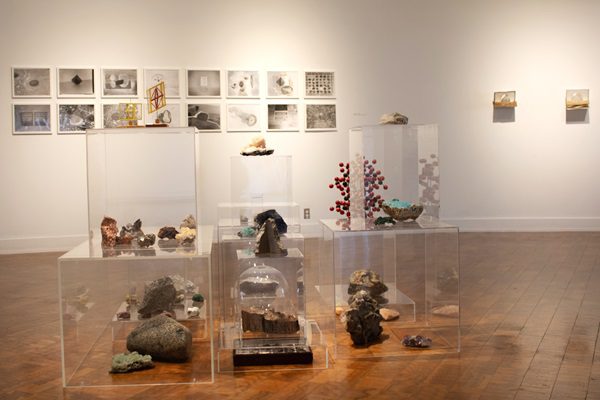Artist Nicole Shaver Intentionally Gathers Rocks, Artifacts, and Art in “Erratic Accretion”

Chunks of concrete housed in a giant metal crate, which look mundane on the outside, hold four-and-a-half decades of history and represent a legacy to many UNC Charlotte alumni. The Belk Tower was a popular and defining fixture of the university until its removal in 2016, and while the tower itself is gone, the university still holds onto a piece of it – many pieces to be exact – which can now be seen in Lambla Gallery.
 Milwaukee-based artist Nicole Shaver was struck by the desire for the university to keep the pieces of the tower’s foundation after all this time, a relic of the past that holds importance to many. Shaver has a strong interest in the overlap of art and geology, a topic she explores in the exhibition “Erratic Accretion.”
Milwaukee-based artist Nicole Shaver was struck by the desire for the university to keep the pieces of the tower’s foundation after all this time, a relic of the past that holds importance to many. Shaver has a strong interest in the overlap of art and geology, a topic she explores in the exhibition “Erratic Accretion.”
On view through March 15, “Erratic Accretion” sparks interdisciplinary conversations through the interplay of art objects and geological specimens. In the exhibition, Shaver combines her creative work with UNC Charlotte’s geology collection, the Belk Tower detritus, and a wide variety of items found throughout campus that were left behind by students.
“As an artist, I’m really drawn to material and what vehicle I can tell stories through, and to me, geology is like that basic building block of our planet,” said Shaver.
The title “Erratic Accretion” has a double, metaphorical meaning. Commonly implying unexpected or irregular behavior, in geological terms “erratic” refers to rocks transported across long distances by glaciers, which then emerge once the ice melts. Likewise, the components of the exhibit were brought together from unexpected – even random – places, remainders of past activity that come together to form a coherent whole.

The geological specimens in the exhibit tell stories of the different locations and times in which they were discovered. The specimens housed in display cases at the gallery’s center come from the collection of John Orchard, a member of Charlotte’s Gem and Mineral Club whose collection was donated to the university in 2015. Alongside these are petrified wood and other larger specimens from the rest of the geology department’s collection. Pieces of Shaver’s personal collection also make an appearance as a part of the ‘found book’ pieces on the wall.
“Geology collections like this are better off displayed for people to see rather than kept hidden,” said Shaver. This sentiment is shared by Valerie Reynolds, assistant teaching professor and undergraduate coordinator for Geology and Earth & Environmental Science in the Department of Geography and Earth Sciences. UNC Charlotte’s geology collection has been largely hidden from the public eye since its donation, but Reynolds hopes to change this starting with Shaver’s exhibition of many of its specimens.
 The non-geological objects hold the stories of today’s students, showing different artifacts which have been left behind, dropped, or discarded by students. These items range from flash drives and batteries to sauce packets and small rocks, all of which are displayed in plexiglass cubes. Though discarded by their initial owner, these objects are now able to hold a reassigned value dictated by the exhibit’s audience. “There’s a human compulsion to put value on something,” said Shaver, “a compulsion to want to save a moment or save value within an object.”
The non-geological objects hold the stories of today’s students, showing different artifacts which have been left behind, dropped, or discarded by students. These items range from flash drives and batteries to sauce packets and small rocks, all of which are displayed in plexiglass cubes. Though discarded by their initial owner, these objects are now able to hold a reassigned value dictated by the exhibit’s audience. “There’s a human compulsion to put value on something,” said Shaver, “a compulsion to want to save a moment or save value within an object.”
“Erratic Accretion” can be viewed in the Lambla Gallery in the Storrs building Monday-Friday from 9 a.m. to 5 p.m. Shaver will travel to UNC Charlotte for the closing reception on March 14 from 5:30-7:30 p.m. and will speak about her work.
As for UNC Charlotte’s geology collection, Reynolds hopes that this exhibition will serve as the catalyst for the specimens to be displayed more prominently at the university. “I’ve made the decision to display some of these and some other samples on the first floor in the McEniry building,” said Reynolds, hopeful that this display will bring in more students interested in studying geology.
Article by Will Loyd; photos by Sunnie Stainback.